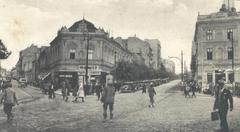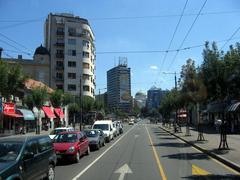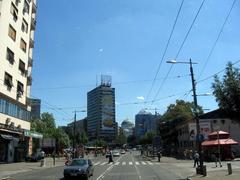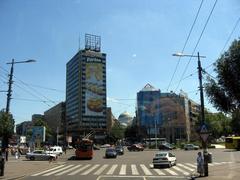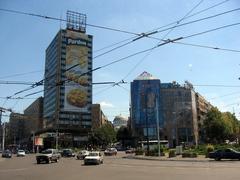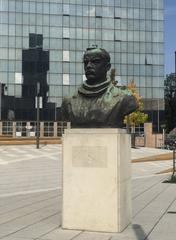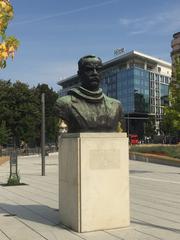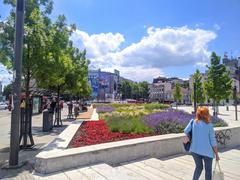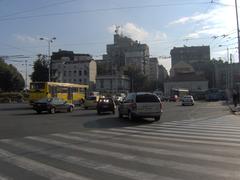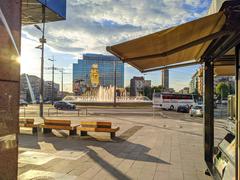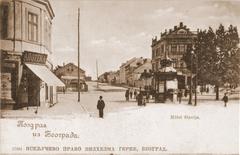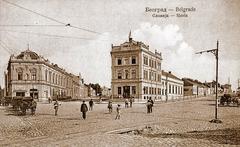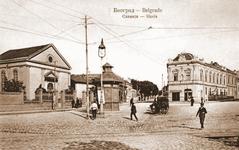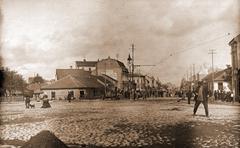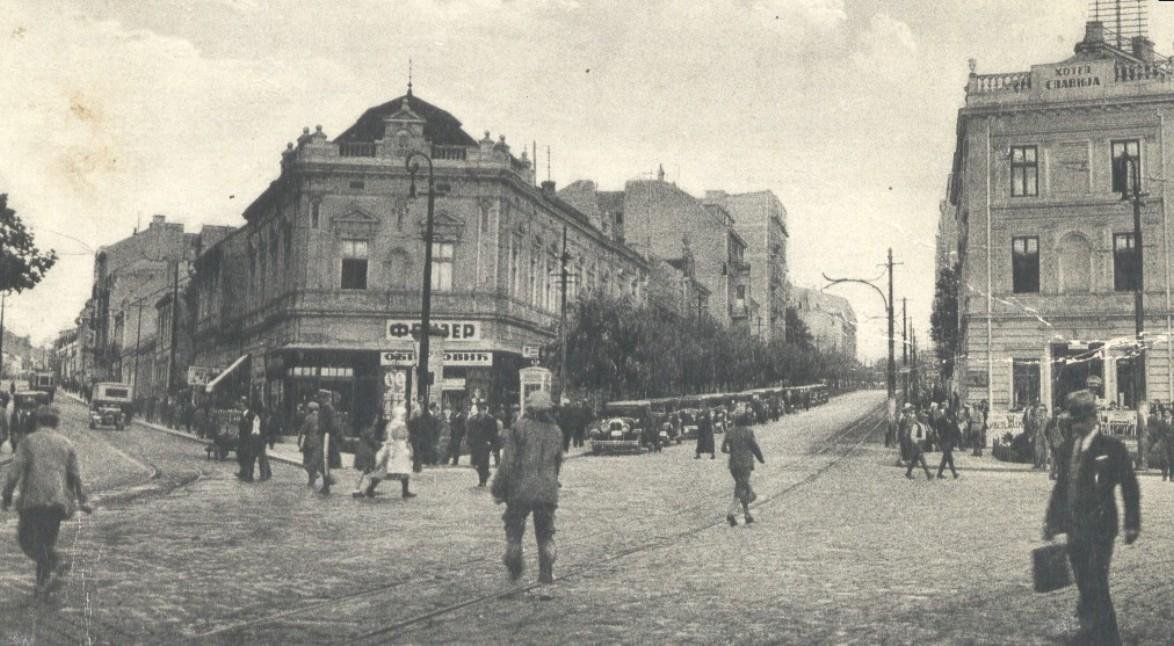
Slavija Square Belgrade: Visiting Hours, Tickets, and Historical Sites Guide
Date: 14/06/2025
Introduction
Slavija Square (Trg Slavija) is one of Belgrade’s most significant and dynamic public spaces, serving as both a transportation nexus and a living symbol of the city’s historical evolution. Once a marshland, it has transformed over nearly two centuries into a bustling urban hub, reflecting Belgrade’s architectural diversity, civic energy, and cultural vibrancy. Whether you’re a history enthusiast, architecture lover, or a traveler seeking authentic experiences, Slavija Square offers a unique window into Serbia’s capital (thenutshelltimes.com; belgrade-beat.com; Belgrade Spots).
This guide provides a comprehensive overview of Slavija Square, including its history, visiting hours, accessibility, ticket details, nearby attractions, travel tips, and essential practical advice for making the most of your visit.
Historical Overview: From Marshland to Urban Landmark
Origins and Early Development
In the early 19th century, the area now known as Slavija Square was a marshy pond on Belgrade’s outskirts, popular for wild duck hunting (eyesonbelgrade.com). Scottish entrepreneur Francis Mackenzie purchased the land in 1879, drained the marsh, and initiated the first urban developments, creating the Englezovac (“English Town”) district (thenutshelltimes.com).
Growth and the Pan-Slavic Influence
The name “Slavija” emerged in the late 19th century, inspired by the pan-Slavic movement. The square’s first notable building, the Slavija Hotel (1882–1888), signaled its emergence as a vital commercial and cultural hub just south of the city center (belgrade-beat.com; wikipedia.org).
20th Century: Urbanization and Modernization
Slavija Square became a key intersection as Belgrade expanded, with ambitious plans for cultural landmarks interrupted by World War II. In the socialist era, the square was renamed for Dimitrije Tucović and saw the construction of modernist structures like the Hotel Slavija and the popular Slavija cinema. Traffic congestion became a defining characteristic as the city grew (wikipedia.org; belgrade.tips).
Contemporary Renovation and Identity
A major renovation in 2017 introduced a striking 32-meter-wide musical fountain at the square’s center, now a nightly attraction. Slavija continues to evolve, balancing its roles as a transport hub, commercial center, and public gathering space (serbia.com; belgrademyway.com; MoreThanBelgrade).
Visitor Information
Visiting Hours
- Slavija Square: Open 24/7 as a public space.
- Musical Fountain: Shows run from sunset until 11 PM, mainly from late spring to early autumn.
Tickets and Entry
- Admission: No ticket or entrance fee is required to visit Slavija Square or view the musical fountain.
Accessibility
- Wide sidewalks, pedestrian crossings with tactile paving, and ramps make the square generally accessible for wheelchair users and those with reduced mobility.
- Due to heavy traffic, always use marked crosswalks and remain vigilant.
Guided Tours and Events
- Many Belgrade walking tours include Slavija Square as a highlight, often in combination with nearby landmarks such as the Saint Sava Temple and Nikola Tesla Museum.
- The square frequently hosts civic events, demonstrations, and cultural gatherings (Counterfire; European Western Balkans).
Urban Layout and Connectivity
Slavija Square anchors Belgrade’s urban grid, where six major streets converge: Kralja Milana, Beogradska, Makenzijeva, Svetosavska, Bulevar Oslobođenja, and Nemanjina (Belgrade Spots). This makes it a central point for both vehicular and pedestrian movement.
Transport: The square is a key public transport hub, served by numerous tram, trolleybus, and bus lines, connecting to all areas of Belgrade.
Surroundings: The area features a blend of commercial, residential, and institutional buildings, green spaces, and is close to numerous major landmarks.
Architectural Features and Styles
Slavija Square is a showcase of Belgrade’s layered architectural history:
- Hotel Slavija: A modernist icon from the Yugoslav era.
- Commercial Buildings: Late modernist and postmodern structures, including banks and shopping centers.
- Residential Blocks: Early 20th-century facades stand beside high-rise apartments.
- Public Spaces: Landscaped areas and the spectacular musical fountain.
The juxtaposition of architectural styles—eclectic, modernist, and contemporary—reflects the city’s turbulent but creative evolution (MissTourist).
Relationship to Nearby Landmarks
Slavija Square is ideally situated for exploring some of Belgrade’s most important attractions:
- Saint Sava Temple: One of the world’s largest Orthodox churches, just a short walk away (Belgrade Beat).
- Nikola Tesla Museum: Showcasing the inventor’s life and work, within easy walking distance.
- National Library of Serbia: A major cultural and architectural site near the square.
- Beogradjanka (Belgrade Palace): A modernist skyscraper visible from the square.
- Tasmajdan Park and St. Mark’s Church: Green space and a monumental Orthodox church nearby.
- Republic Square and Knez Mihailova Street: The heart of downtown Belgrade, accessible by tram or on foot (MissTourist).
Notable Civic Events and Cultural Life
Slavija Square is a focal point for public demonstrations, rallies, and cultural events. In late 2024 and early 2025, it was the site of major protests, drawing crowds of over 100,000 demanding government accountability (European Western Balkans; EUNews). Its central, symbolic location makes it the preferred venue for civic expression.
Practical Travel Tips
- Best Time to Visit: May and June offer pleasant weather. Evenings are best for the musical fountain show.
- Getting There: Use trams, buses, or trolleybuses; taxis are also readily available.
- Photography: The illuminated fountain and views of Saint Sava Temple are especially photogenic.
- Dining: A diverse range of eateries, bakeries, and cafés are available; Skadarlija, Belgrade’s bohemian quarter, is nearby for traditional Serbian cuisine.
- Accommodation: Several hotels, including the classic Hotel Slavija and modern options, are located around the square.
- Safety: The area is generally safe, though caution is advised when crossing busy streets.
- Accessibility: Improved in recent years, but always use marked crossings and be mindful of traffic.
- Language: English is widely spoken in tourist areas.
Frequently Asked Questions (FAQ)
Q: What are Slavija Square’s visiting hours?
A: Slavija Square is open 24/7. The musical fountain operates from sunset to 11 PM in the warmer months.
Q: Is there an entrance fee or ticket required?
A: No, access to Slavija Square and the musical fountain is free.
Q: How do I get to Slavija Square?
A: The square is a major public transport hub accessible by tram, bus, trolleybus, and taxi from anywhere in Belgrade.
Q: Is the square accessible for wheelchair users?
A: Yes, with improved crossings and ramps, but always remain vigilant due to heavy traffic.
Q: Are guided tours available?
A: Many city tours include Slavija Square along with other key landmarks.
Q: What are the best times for photography?
A: Evenings during the fountain’s light and music shows, and early mornings for fewer crowds.
Additional Points of Interest Near Slavija Square
- Avala Tower: For panoramic views, accessible by public transport.
- Novi Beograd: A showcase of post-war modernist architecture, easily reached by bus.
- Kalenic Market: One of Belgrade’s largest open-air markets, ideal for sampling local produce (MissTourist; Belgrade Beat).
Summary
Slavija Square represents the essence of Belgrade’s urban vitality and historical complexity. Its layered architecture, central location, and dynamic public life make it a must-see for any visitor. As a gateway to key landmarks like the Saint Sava Temple and Nikola Tesla Museum, and a hub of civic activity, Slavija Square is more than just a transport intersection—it is a living emblem of the city’s past, present, and future (wikipedia.org; Belgrade Spots; Jetsetting Fools; MoreThanBelgrade).
For the latest event updates, travel tips, and curated guides, consult Belgrade’s official tourism resources and consider downloading the Audiala app for personalized itineraries.
Official Sources and Further Reading
- Belgrade Beat: Slavija Square
- Belgrade Spots: Slavija Square
- Jetsetting Fools: Things to Do in Belgrade
- MoreThanBelgrade: Famous Musical Fountain
- European Western Balkans: Large Protest
- Counterfire: Youth and State Clash
- The Nutshell Times: Mackenzie, Socialists and McDonalds
- Belgrade Tips: The Heart of Belgrade
- Wikipedia: Slavija Square
- MissTourist: Belgrade Itinerary
